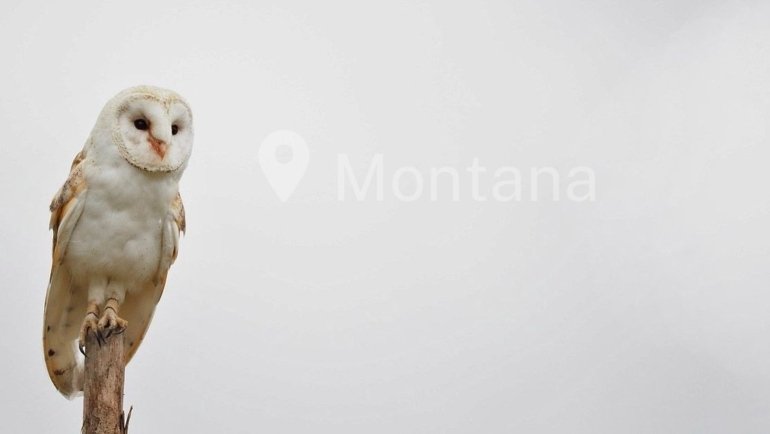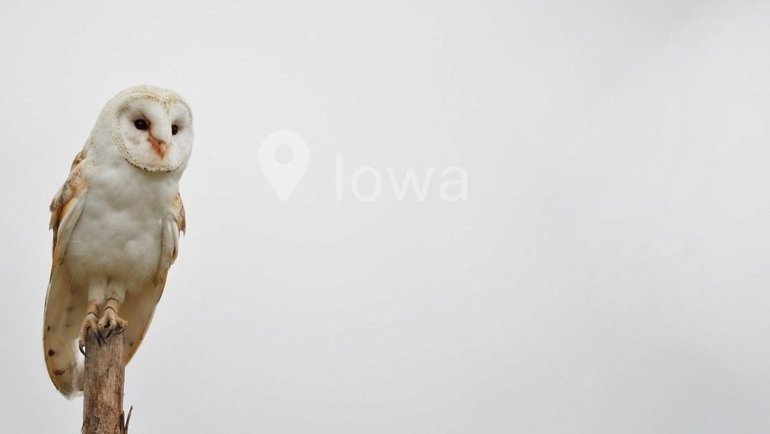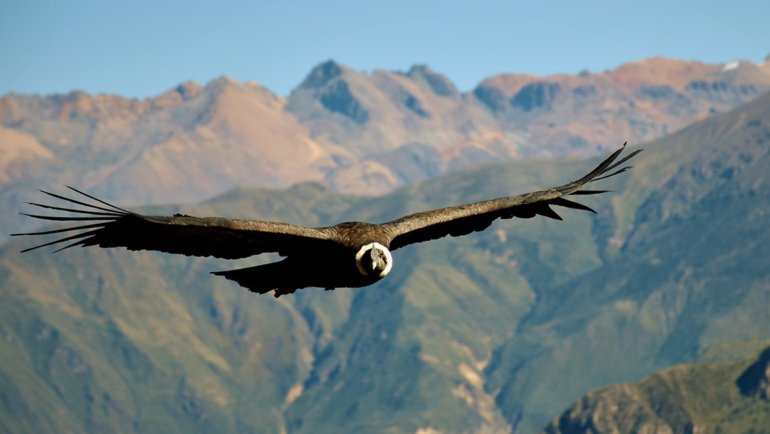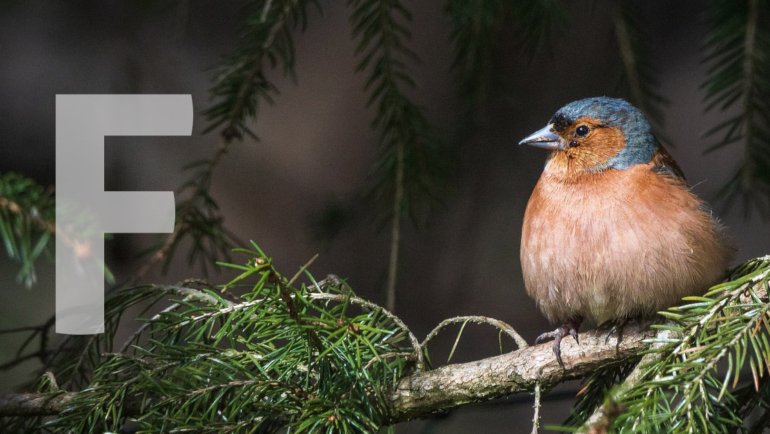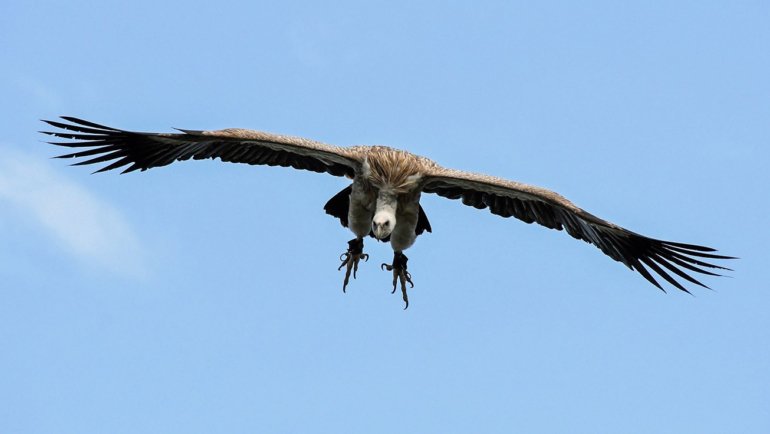Welcome to our vibrant exploration of the world’s yellow parrots! From the shining tropical rainforests to the cozy corners of our homes, yellow parrots offer a burst of sunshine and delight in our lives. The bright yellow hues of these parrots are not only visually stunning but also a remarkable result of nature’s ingenuity.
Whether you’re an avian enthusiast seeking your next pet or a wildlife lover exploring nature’s palette, this journey through the realm of yellow parrots promises to enlighten and amuse.
Indian Ringneck Parakeet – Yellow mutation
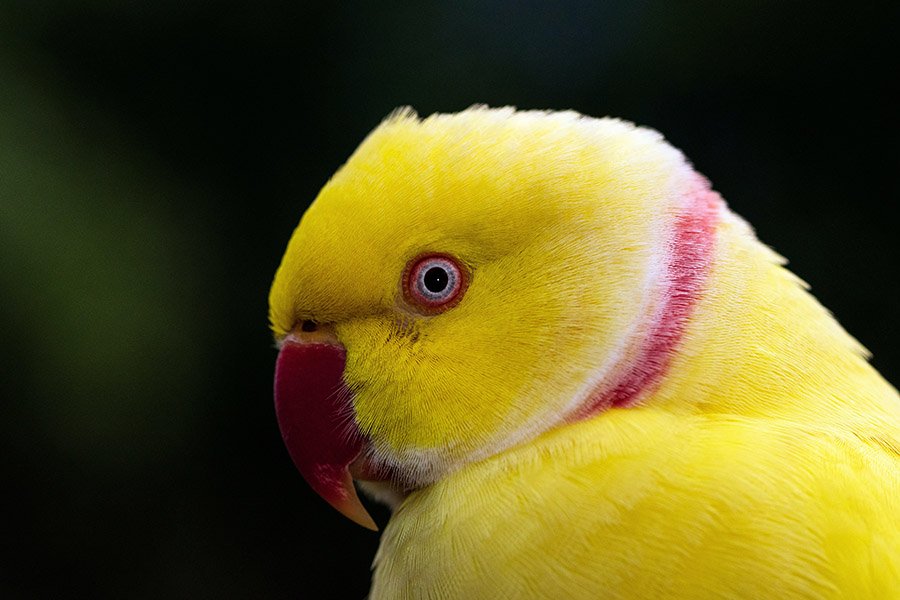
- Scientific Name: Psittacula krameri
- Size: 40 cm (16 in)
- Lifespan: 20 – 30 years
- Where found: Indigenous to Asia and Africa, but are also found in urban areas around the world due to the pet trade
The Indian Ringneck Parakeet is a medium-sized parrot known for its unique ring-necked design and vibrant colors. The yellow mutation, sometimes referred to as the Lutino Indian Ringneck, is a captivating sight with its bright yellow plumage, red beak, and striking white ring around its neck.
Indian Ringnecks, including the Lutino variety, are known for their intelligence and impressive mimicking abilities. With proper training and socialization, they can learn a variety of words and phrases, making them entertaining companions.
These birds require a lot of stimulation and exercise due to their active and curious nature. They enjoy toys, puzzles, and the opportunity to fly and explore. These parakeets also have a strong need for social interaction, and they can become depressed or develop behavioral problems if left alone for too long.
Did you know? Indian Ringneck Parakeets are among the few bird species that can see the full spectrum of colors. They can even see ultraviolet light, which is invisible to the human eye! This ability helps them find food, choose mates, and detect predators in the wild.
Pacific Parrotlet – Yellow Mutation
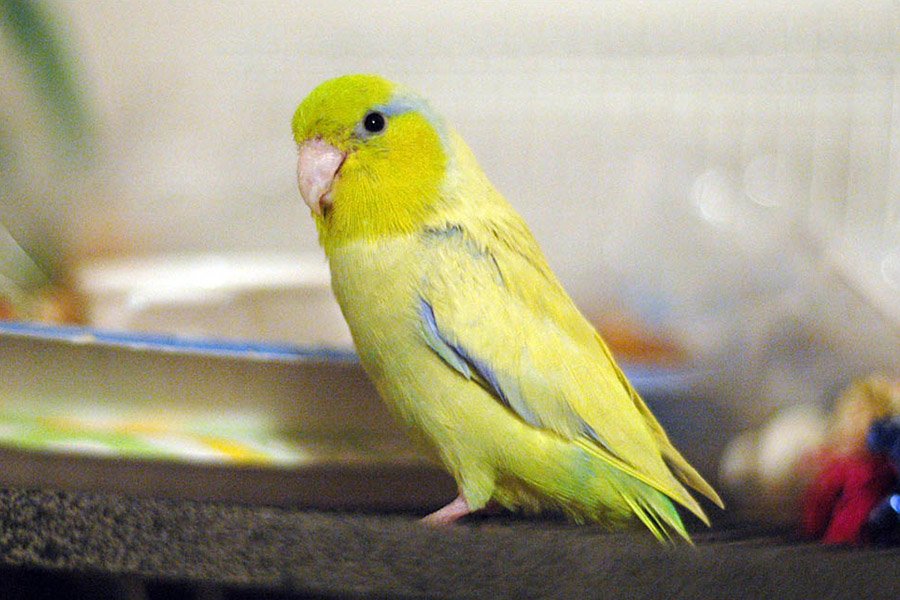
- Scientific name: Forpus coelestis
- Size: 4.5-5 inches (11.4-12.7 cm)
- Lifespan: 20 to 30 years
- Where found: South and Central America
The Pacific Parrotlet, especially the Yellow mutation, brings a splash of the tropical sun into our lives with its radiant, yellow plumage. Despite their small size, these parrots are known for their vivacious spirit and assertive personality. Their native habitats range from subtropical or tropical dry forests to heavily degraded former forest regions in Central and South America.
Sporting a lively personality, Pacific Parrotlets are social creatures, engaging with their human caregivers and seeking regular interaction. They are also known for their intelligence, making them a joy to train. Despite their size, they can be quite feisty and will often assert themselves. However, their friendly nature and charming characteristics have made them a popular pet choice worldwide.
Did you know? Even though they’re small, Pacific Parrotlets have a large personality and are often referred to as “pocket parrots” because of their small size and their love for nestling into their owners’ pockets or collars.
Golden Conure
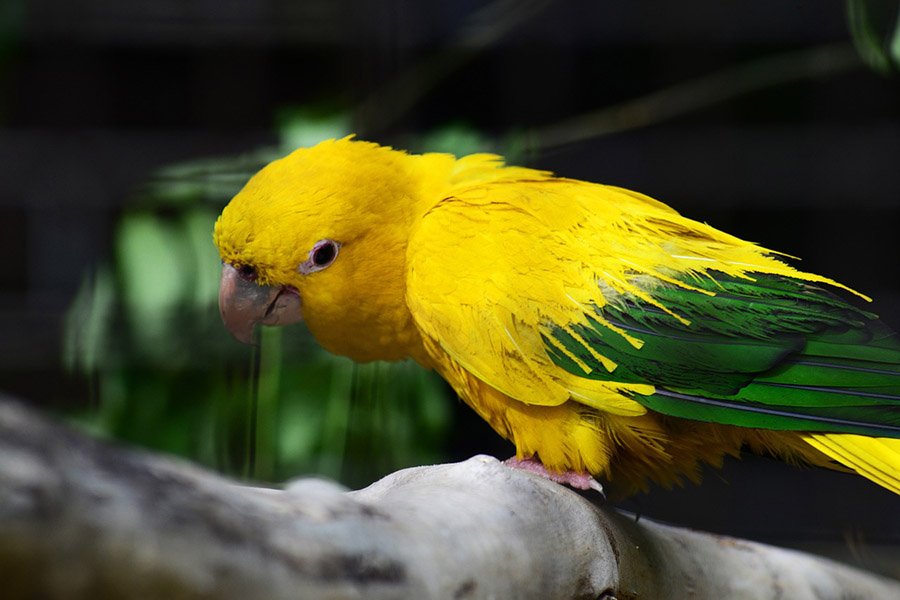
- Scientific name: Guaruba guarouba
- Size: 13 inches (33 cm)
- Lifespan: 30 years
- Where found: Northern Brazil
Golden Conures, also known as Golden Parakeets, truly live up to their name with their gorgeous bright yellow plumage. This bird species primarily inhabits the undisturbed tropical rainforests of northern Brazil. They are quite sociable, known to live in groups of up to 30 individuals. These parrots have a strong sense of community, often nesting close to each other in what can be described as bird condominiums.
As pets, Golden Conures are extremely affectionate, forming close bonds with their human companions. They are highly intelligent and can learn a variety of tricks, making them a delight for bird enthusiasts. Despite their charming qualities, their status in the wild is threatened due to habitat destruction and illegal pet trade.
Did you know? Golden Conures have an unusual breeding strategy where non-breeding birds in the group help to take care of the chicks – a behavior called ‘cooperative breeding.’
Sun Conure
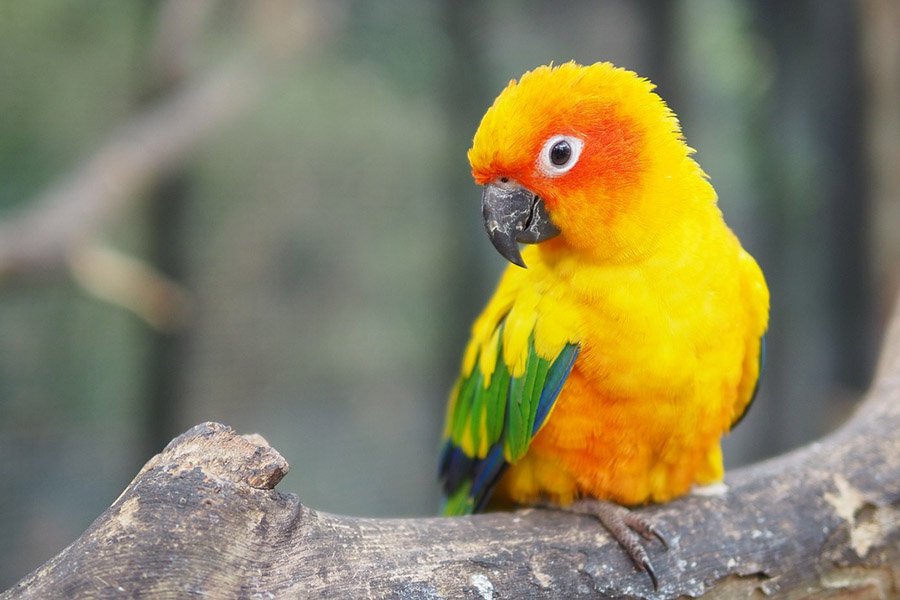
- Scientific name: Aratinga solstitialis
- Size: 12 inches (30 cm)
- Lifespan: 25 to 30 years
- Where found: Northeastern South America
With their fiery orange and yellow plumage, Sun Conures are indeed a mirror reflection of a beautiful sunrise. Originating from the northeastern regions of South America, they inhabit savannah-like habitats, palm groves, and the edge of forests. In the wild, they can be seen in large, noisy flocks creating a breathtaking spectacle against the sky.
Sun Conures make great pets due to their lively and playful personality. They are affectionate and form close bonds with their owners. These birds are also quite talkative, capable of mimicking human speech, although their vocal range is not as extensive as some larger parrot species. Their bright color, paired with their fun-loving nature, make them a delightful addition to any family.
Did you know? Sun Conures change their color as they age! They are born with a greenish plumage, which slowly transforms into a vibrant yellow and orange as they mature.
Blue-and-Gold Macaw
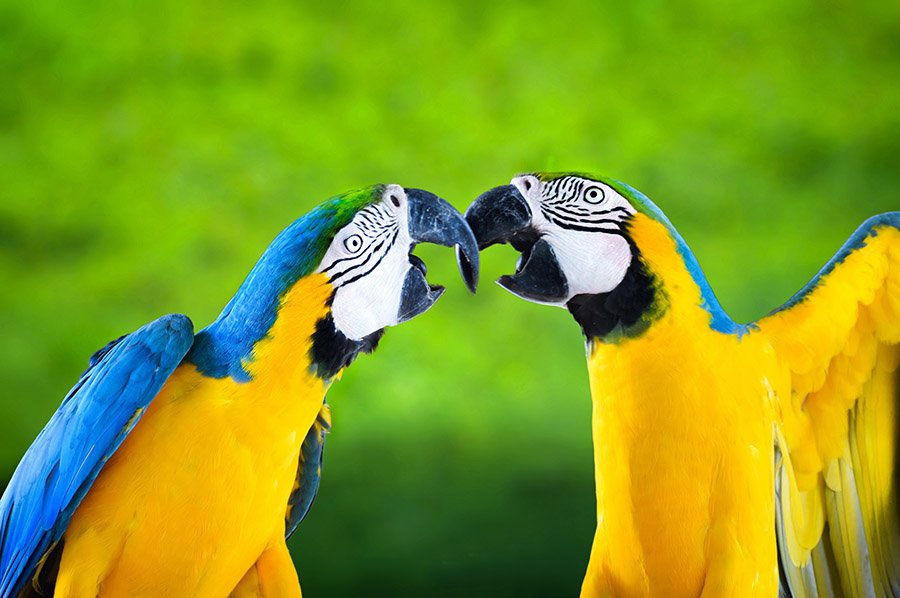
- Scientific name: Ara ararauna
- Size: 30-34 inches (76-86 cm)
- Lifespan: Up to 60 years
- Where found: South America
Despite the name, Blue-and-Gold Macaws are not just blue and gold. These parrots are a wonderful splash of colors, with a predominantly bright blue top side, a golden underside, a green cap on their heads, and a black chin. They are native to the subtropical rainforests of South America, living in large, noisy groups that roost in trees high above the forest floor.
In captivity, these birds are known for their sociable and friendly nature. They’re extremely intelligent, capable of learning many tricks and mimicking human speech. However, their large size and need for space means they require dedicated care and plenty of room to stretch their wings.
Did you know? Blue-and-Gold Macaws have strong beaks that can easily crack nuts and seeds, but they also use their beaks as a “third foot” to help them climb trees!
Lovebird – Yellow mutation
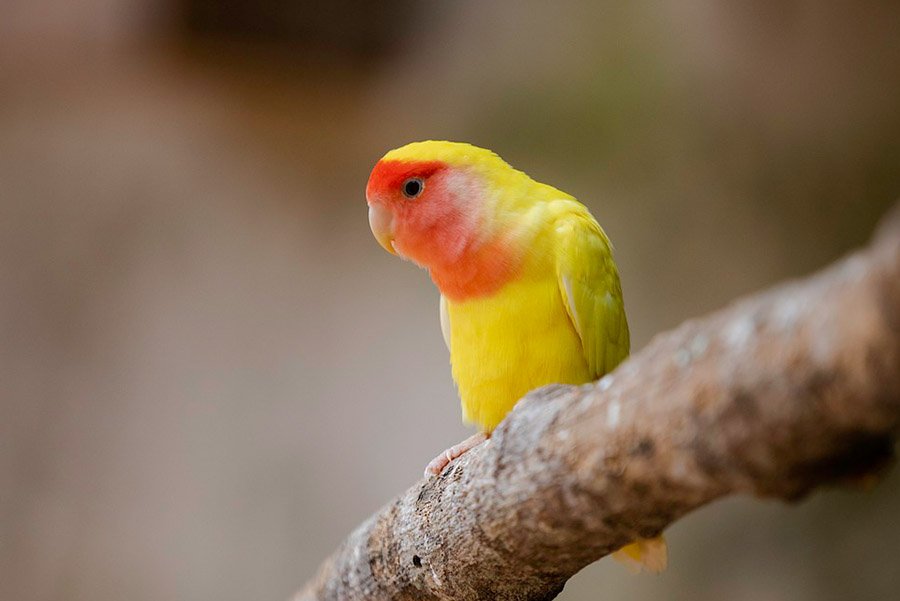
- Scientific name: Agapornis spp.
- Size: 5-7 inches (13-17 cm)
- Lifespan: 10-15 years
- Where found: Africa, and domesticated worldwide
Lovebirds, especially those of the yellow mutation, are a delightful sight. Naturally green, selective breeding has resulted in several lovebird color variations, including this sunny yellow. These parrots are native to Africa, but have since been bred and kept as pets worldwide.
Pet lovebirds are known for their lively nature, curiosity, and strong bonding tendencies. They are very social birds and thrive on interaction, often forming deep bonds with their human caretakers or a bird companion. Despite their small size, they are full of personality, providing endless entertainment for their owners.
Did you know? The name “Lovebird” comes from these parrots’ strong pair bonds, as they are often seen sitting closely and preening each other, which looks like they are “in love.”
Budgerigar – Yellow mutation
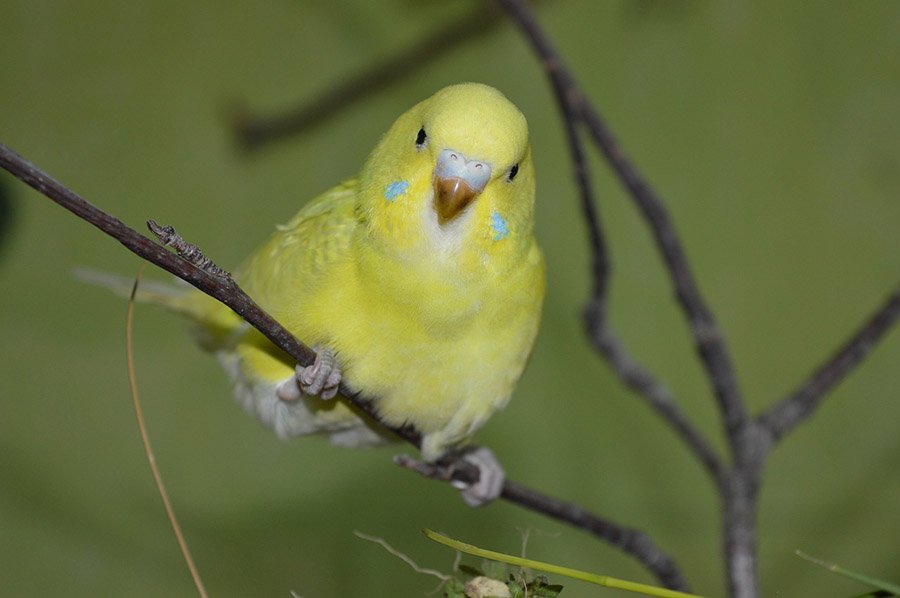
- Scientific Name: Melopsittacus undulatus
- Size: 18 – 20 cm (7 – 8 in)
- Lifespan: 5 – 10 years
- Where found: Australia
The Budgerigar, often known as the Budgie or Parakeet, is a small parrot native to the dry parts of Australia. These birds have been popular pets for over a hundred years, and many color mutations have been bred, including the yellow Budgerigar. The vibrant yellow of these budgies can vary from a light lemon hue to a deep golden shade, often marked with attractive, wavy black stripes.
In the wild, budgerigars live in large flocks and are extremely social creatures. They enjoy the companionship of their own kind and, when kept as pets, thrive on interaction with their human caregivers. These intelligent birds are known for their ability to mimic human speech and are loved for their friendly and playful demeanor.
Despite their small size, budgerigars are active and need plenty of exercises. They are excellent flyers and climbers, and toys are essential for their mental stimulation.
Did you know? Budgerigars have an exceptional ability to mimic human speech. In fact, a Budgerigar named “Sparkie Williams” holds the record for the largest vocabulary of any bird, with a total of 531 words and 8 complete nursery rhymes!
Cockatiel – Lutino mutation
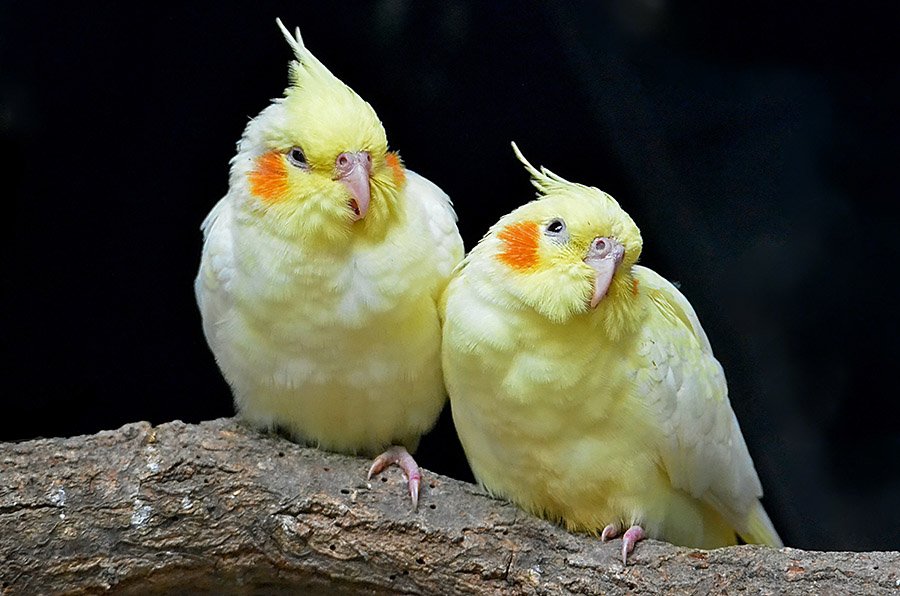
- Scientific name: Nymphicus hollandicus
- Size: 12-13 inches (30-33 cm)
- Lifespan: Up to 25 years
- Where found: Australia, and domesticated worldwide
The Lutino mutation of the Cockatiel, a native Australian bird, is a popular pet choice due to its striking yellow or yellow-white coloring, contrasting with its vivid orange cheek patches. The lutino mutation eliminates the grey color found in wild-type Cockatiels, resulting in birds that are a charming yellow or cream color.
As pets, Cockatiels are treasured for their friendly, affectionate nature and their entertaining whistles. They are intelligent birds, capable of learning simple tunes and mimicking household noises. While they enjoy interaction, they also appreciate time out of their cages to stretch their wings. Despite their small size, they require a good deal of mental stimulation and exercise to keep them happy and healthy.
Did you know? Unlike many birds, both male and female Cockatiels can mimic sounds and tunes, though males typically exhibit this behavior more frequently and are often better at it. The Lutino mutation, regardless of the bird’s gender, often results in a bird that’s a talented mimic!
What Makes Parrots Yellow?
The beautiful yellow hues seen in parrots are primarily the result of two factors: genetic mutations and the presence of specific pigments. Many parrots we see as pets that exhibit yellow feathers are often selectively bred for this characteristic. For example, the Lutino mutation in Cockatiels and Parrotlets is a genetic variant that suppresses the production of melanin, a pigment responsible for darker colors, and allows the yellow pigmentation to dominate.
The yellow color in parrots is due to pigments called psittacofulvins, which are unique to parrots. These pigments, combined with the structure of the feather, can also influence how we perceive the color. The microscopic structure of a bird’s feathers can scatter light in a way that intensifies color, making the yellow even more vibrant.
The yellow coloration might give these birds an advantage in their natural habitats. For some, blending into a sunny, dappled environment can be an effective way to avoid predators. For others, bright colors might be a way to attract mates during the breeding season.
Final Thoughts
Exploring the world of yellow parrots, we’ve encountered a fascinating array of species, each with its unique charms. From the compact Parrotlets to the grandeur of the Blue-and-Gold Macaw, these birds present a dazzling display of sunny hues that never fail to captivate us.
Whether they are flitting about in their natural habitats or charming us from our living rooms, these yellow parrots bring a touch of tropical sunshine into our lives. As we’ve seen, there’s more to these creatures than meets the eye, and each species contributes in its own way to the vibrant tapestry of avian life.
So next time you see a yellow parrot, take a moment to appreciate the complexity behind its brilliant colors.
